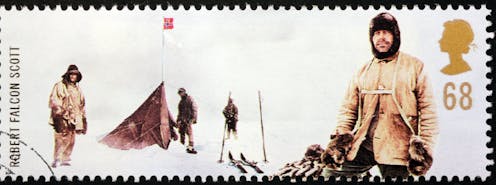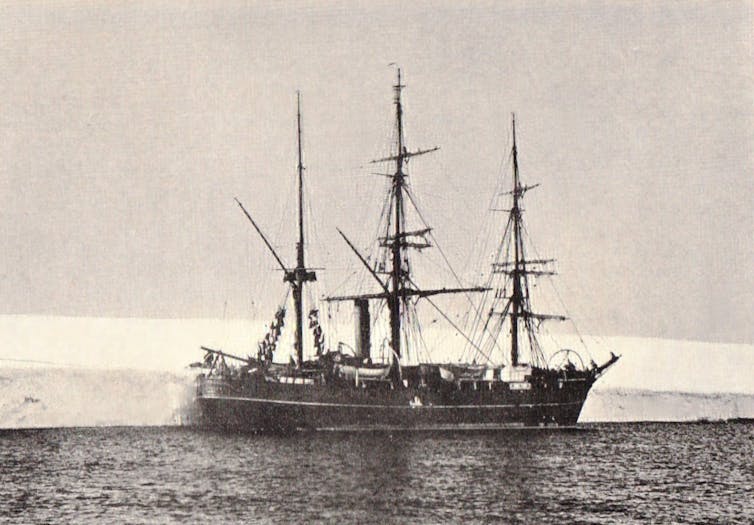
Antarctica is the most inhospitable continent on earth. It’s dry, cold, and completely dark for months of the year. Edwardian explorers were some of the first to brave the Antarctic winter, developing new knowledge still drawn upon by scientists today.
The Discovery expedition (1901–4) played a key role in the history of polar exploration. It was led by the Royal Navy commander Robert Falcon Scott, a pioneering polar explorer who died in 1912 after attempting to reach the south pole. The expedition’s third lieutenant was Ernest Shackleton, who led three further journeys to the continent.
Both men would become household names, and it was the Discovery expedition that launched their careers. Together, they set a record in December 1902, coming closer to the south pole than anyone had before.
The journey also shaped how both men thought about health, particularly how to prevent and treat scurvy. My research examined how the expedition’s officers, medics and organisers sought to keep the explorers healthy in Antarctica, particularly during the polar winter. Because of this work, nobody on the expedition died from poor health (though two men were killed in accidents).
Table of Contents
Diet
Food was a matter of life or death for polar explorers. Problems with tinned foods are widely believed to have contributed to the demise of the Franklin expedition, which went missing in the Arctic in the late 1840s.
Concerns about food were also driven by the idea that badly preserved meat caused scurvy (though we now know it’s caused by a shortage of dietary vitamin C).
Like health experts today, Edwardian explorers were concerned about both the variety of food and its quality. “Give the men good healthy food and I guarantee you will have no diseases,” Norwegian Arctic explorer Fridtjof Nansen advised the Discovery expedition’s medic before departure.
The expedition’s organisers tested food samples to analyse their nutritional content. All tinned foods were also inspected before the expedition to check for signs of decay. Despite these precautions, the explorers found that much of their tinned food was rotten by the time they reached Antarctica. This was due to the poor quality of the canned foods they’d been supplied.
To prevent the men eating contaminated food, the expedition’s medics checked every tin before consumption. But, because their tinned food didn’t contain much vitamin C, the expedition still suffered an attack of scurvy. This attack only ended once they began eating more fresh seal meat.
Scott and Shackleton now saw fresh food as the best way to prevent and treat scurvy, though neither understood why. We now know that it’s because lightly cooked meats contain vitamin C.
The explorers came to view processed foods as more dangerous than fresh foods. Such discussions seem remarkably like recent debates about the health risks of ultra-processed foods. The explorers put emphasis on always having access to fresh meat.

Wikimedia Commons
Air
The explorers also worried about the quality of air on the ship.
Scientists now understand air pollution has negative health effects. But in the Edwardian era, poor air quality was understood differently.
Bad air was viewed a threat because of older medical theories that argued poor health was caused by “miasmas” – rotting gasses produced by decomposing matter. Cold, draughts and damp were also considered dangerous.
Specially-built ventilation systems were installed in the ship. The system employed two stoves to ventilate the explorers’ living quarters with warm air. But once in Antarctica, the system proved unreliable and used lots of fuel. Their ship was also less airtight than expected, meaning it was ventilated without needing to use the specially built systems.
But not everyone agreed on the importance of ventilation. Scott commented that “the question of fresh air and ventilation was one that afforded us a constant field of argument.” Even the expeditions’ two medics had different views.
One thought it was more important to keep living quarters ventilated by opening the windows every morning. The other argued it was better to keep warm, even if the air wasn’t as fresh.
They never resolved this disagreement, but did reach a compromise about how often windows should be opened.
Exercise
There was more agreement between the explorers was on the importance of exercise. Even in the 1900s, exercise was seen as an important way to stay healthy, able to counter the perceived negative effects of modern, urban living.
In the Antarctic summer, the explorers spent most of their time sledging. This was backbreaking work, pushing the explorers to their physical limits.
But in winter, the explorers would be on or near their ship. To stay healthy they went on daily walks. As the expedition’s second in command commented, “There is no doubt that one felt better after a sharp walk over the ice.” Such strolls were psychologically important, providing brief opportunities for privacy and reflection. Scott noted: “Throughout most of the winter most of the officers have preferred to take their daily walk alone.”
The explorers also played team sports, such as football and hockey and went tobogganing. The expedition’s junior medic claimed that the “air and exercise” were the key to sleeping well and maintaining an appetite during the polar winter.
On an Antarctic expedition, staying physically and mentally healthy was a question of survival, so it’s no wonder explorers spent so much time thinking about such details.
Many of the health measures employed on Scott and Shackleton’s first expedition are similar to those used today. Food, air quality and exercise are still understood as important to good health. But compared to these Edwardian polar explorers, we now have a much better understanding of why.
![]()
Edward Armston-Sheret receives funding from the Institute of Historical Research. He has received funding from the Arts and Humanities Research Council, the Royal Geographical Society (with IBG), and the Royal Historical Society.





























